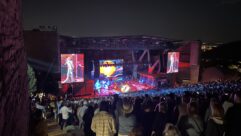Bright opportunities
Dec 1, 1999 12:00 PM,
Jerry Colmanero
As an A-V systems contractor, your customers may ask if you can dolighting, which may pose either a dilemma or an opportunity – to be or notto be a lighting contractor. Choosing to diversify your business as asystems contractor offers many paths of specialization, lighting systemsbeing just one of them. Traditionally, lighting systems have been left upto the electrical contractor to implement with an electrical engineer asthe designer or consultant, but a diverse field of venues, including sportsstadiums, theatres, conference rooms, multipurpose facilities and churches,has widened the range of applications that are needed for lighting. Thisarticle is primarily concerned with systems contractors’ considering entryinto the lighting systems contracting market and some of the situationsthey may encounter at the onset. Most lighting systems fall into threedistinct groups – theatrical, architectural and presentation.
Theatrical systems are specifically for performance spaces where plays,musicals, symphonies and other events take place on a designated stage, andthe audience is primarily an observer. Usually, a theatrical lightingsystems contractor is in the business of supplying not only the lightingequipment, but also rigging, curtains, set construction, risers and anytheatre supplies. A systems contractor looking at theatrical lightingsystems would have to consider a wide range of specialties in order tocompete competently with companies versed in the particulars of thetheatre. It is my recommendation that unless a separate dedicated divisiondevoted to the theatre market is considered for your business, theseapplications should be left to the specialists.
The electrical contractor of a building project generally installsarchitectural systems. General interior and exterior lighting is covered.Simple control is used and is not integrated with the theatrical system.The architect or the electrical engineer designs the system to fit thegeneral illumination needs of the building. Board meeting rooms may have abit more sophisticated control to dim lights during a video presentation,and this may or may not bein conjunction with the A-V control.
The combination of both theatrical and architectural lighting into onesystem is not a new concept, but because of the market demands for newlevels of control sophistication, a new category needs to be defined. Forthe purposes of this article, I will call this new segment “presentationlighting”. Systems contractors stand at the threshold of this newpresentation lighting segment, and in this segment are the keys to how asimple school play or church service is transformed into a participatoryevent.
Churches, above all, have had the greatest impact on the A-V installationindustry. A church may have a 40-piece choir, a full orchestra, songleaders, a video presentation and a drama presentation all in one service.This has increased the demand for the highest quality in audio in such atough environment as those with high reverb times, many open mics, pastorswho go out into the congregation and guest artists taking the audio systemto the cutting edge to bring about the best presentation. Likewise, thechurch is not the best environment for video, but the demand for quality ishigh. The congregation must see the image at wide angles in a high ambientlight building, and at the same time, the system must not distract thecongregation from the service itself but just be an informational source.Presentation lighting demands are no less.
Typically, a church does not want to be a theatre. Theatrical stylepresentations may happen from time to time on the church altar area eventhough there may be no altar, yet the congregation is usually an activeparticipant. There is no proscenium, no wings, no backstage and no built upsets as we would expect in a theatre. Rigging and counter-weight systemsare not used and usually not planned for in church construction. Somechurches, however, produce dramas every bit as compelling and complex asany Broadway show, but the church must still remain a church. Guestspeakers, informational seminars and various youth educational activitiestake place in the church, yet a church is not a classroom or a boardmeeting room.
What divides the church environment from the theatrical and thearchitectural designs of lighting is that the presenter (pastor, choir,musical group and drama team) and the audience as a congregation interactwith each other. This does not happen in any other situation at this level.Lighting control is used in this situation not to divide the presenter andthe congregation, but to enhance the sense of unity churches demand. Thereis no curtain of light and dark that comes between the participants the wayit would in a darkened theatre or in a meeting room where the audience mustfocus to the front.
“Do you do lighting?” I am sure that at one time or another you, as acontractor, have heard this question asked. You must arm yourself with someself-reflection before answering yes to a potential customer and realizethat with any area of specialization, education and trained personnel arethe keys to success. Theatrical systems with the full complement of riggingare best left to companies that are committed to that field. Typicalarchitectural systems fall under the realm of the electrical contractor.Presentation lighting leads the system contractor to integrate hiscustomer’s needs to have full presentation capabilities with the A-Vsystems he is installing and/or designing.
There is a basic short list of requirements for presentation lightingcontrol that a contractor should consider when choosing a line of products.Levels of quality and performance for audio systems, for example, haveevolved to meet the market demands, and lighting control systems are nodifferent in this respect. For example, the product must be UL listed;there are no compromises here for the sake of safety and your own businessliability.
DMX
Further, few protocols have become the reigning standard in their chosenfield as DMX512. From the chaos of almost zero compatible devices in 1986,the year of the standard’s initial publication, there are today fewlighting control devices manufactured that are not compatible with DMX512.The present version is the USITT DMX-512 1990. DMX512 was originallyenvisioned as an additional control protocol to be used alongside existingprotocols. Rather than coexist, it has displaced almost all proprietaryprotocols. The standard is maintained and published by a trade organizationcalled the USITT (United States Institute for Theatre Technology).
DMX becomes the common language to the dimming system from the lightingcontrol console and/or A-V control panel. Most architectural systems do notuse DMX as their primary control protocol, but in order to have asuccessful integration of theatrical and presentation lighting, DMXultimately must be present at the dimming section of the lighting. Manyarchitectural dimming manufacturers either offer a separate interfaceoption for DMX or already have a port for the connection of DMX.
DMX uses an XLR five-pin connector, although some manufacturers havesometimes used the three-pin connector. Belden 9842 is a common cable usedfor install applications. DMX is a bit fussy about the cables through whichit is propagated, and even though I have seen Belden 8451 used with somesuccess, DMX is still data, and what works and what is correct are twodifferent things. Refer to Table 1 for pin connections. You will noticethat pins 4 and 5 are designated as spares. Various companies have usedthese to transmit data about dimmer and control status, contact closure forremotes, and other control protocols. A few years ago, the USITT issued awarning about some companies’ sending voltage down the spares, whichreportedly resulted in equipment damage when mixed and matched withdifferent manufacturers using the spare pins for different applications.
The theoretical length limit of a DMX512 cable (from source to finaltermination) is around 3,000 feet (914 m). To work reliably at thisdistance, you must have perfect source, termination and cable of adequatecross-section. The data rate for DMX512 signals is 250,000 bps. This isfast enough to put a DMX512 signal into the category of signals knows as RF(radio frequency) Because of this, I have seen some enterprising installswhere parallel T-splits were used, creating an RF antenna, and to use apurely technical term, the results messed with the DMX transmission. Withthis arrangement, there is an unterminated length of cable hanging off thesplit, and this can cause all sorts of problems. Although the circuits allcheck out fine with a meter, when DMX data is actually flowing through thewire, all sorts of odd things happen. The DMX signal must be properlyterminated. A simple resistor of 120 V to 150 V connected between pins 2and 3 of the five-pin connector of the last device in the line solves thisproblem.
Additional DMX termination points throughout a facility allow the user toadd additional dimming or automated lighting for special events. At thesepoints of termination it is advisable that a switch designed to introducethe termination resistor into the circuit be installed so that whenequipment is added for temporary applications termination is a simpleoperation, and the integrity of the signal is maintained.
Architectural interface
Most architectural lighting systems offer the ability to set up variousscenes or looks for the general lighting of a facility. A simple wall panelwith access to these scenes placed at the entryway of the building iscommon. Various manufacturers have developed their own control protocols,digital and analog, for this application. Development of these protocolshas happened outside of the realm of DMX because DMX is a standarddeveloped primarily for the theatre market, and it has been only recentlythat a demand has emerged for integration of architectural and theatricalstyle control. When looking at a dimming system, whether it was designedoriginally for the theatre or the architectural markets, make sure that themanufacturer offers an interface. These two types of control systems mustaddress a common dimming system, regardless of the type of controlprotocols used.
The most common scenes for regular church services, weddings and funeralsare accessed simply from the architectural control panels. Moresophisticated events and their scenes are controlled from a dedicatedlighting control desk. The ability to dim the house lights for specialpresentations from both control systems enables the greatest amount offlexibility with the least number of operators and setup time.
Scene memory
The architectural control system and the theatre control console must havethe ability to operate independently of each other. This may seem like acontradiction to integration, but some systems rely on the theatre controlconsole to have extra pages of memory for house lights and architecturalcontrol. In dedicated theatre systems, this is common, but for presentationlighting, it is not acceptable. In applications of presentation lightingtechnology, a lighting system operator is not always needed, and a certainlevel of automation is often required. Architectural control systems arenot necessarily designed for theatre use and do not have crossfade andmulti-scene control.
An architectural lighting system offering less than 24 dedicatedarchitectural scenes in memory could not cover the various types of eventstaking place in the church or multipurpose facility. Scene memory for thearchitectural system should reside exclusively in the architectural dimmingsystem yet may still be overridden by the theater style lighting consolevia a DMX port. The scene control residing in the theater console shouldremain independent of the architectural system.
Subpatch
Softpatching is the method by which DMX is routed from specific theatrelighting console channels to the dimmers. A single DMX line can address upto 512 channels of dimming control. There can be more than 512 actualdimmers if particular dimmer channels share the address routing. Thetheatre console can have few, say 32, control faders, but those faderchannels are routed to any number of the 512 dimming control channels. Anindependent Softpatch for the architectural control system is a must.Because the dimming system is shared by both the architectural and theatrecontrol, the dimming system must make the distinction between the commands.In a theatre environment, the audience area goes dark, and all the lightingcontrol is dedicated to the stage area; any architectural control can besimple and independent, but presentation lighting presents a set ofdifferent demands.
Here is a common applications example. In a wedding, the focus is decidedlyon the couple being married. Upon the bride’s entry into the church theaisle lights are brought up 100%, the congregation area is dimmed to 70%,and the altar area slowly fades up to between 50% and 100% as the bridenears. During the vows, the couple wants to be brightly lit and thecongregation area of the church dimmed to 50%. As the couple marchestogether to exit the church, all lights are brought up to 100%. This wouldobviously involve control over the theatre-style lighting at the front ofthe church and the church’s architectural lighting, which only anintegrated system can provide.
Softpatch capability allows the control commands to be routed to the properdimmers for the above applications example; a different softpatch may beused for regular Sunday services. Softpatching should not be confused withscene memory; softpatching gives you the ability to use certain dimmersthat may be used for architectural functions. Through this control thearchitectural lighting becomes a part of the dynamics of the presentation.
Bring it all together
People are the most important aspect in the design and installation ofpresentation lighting. Churches want to be dynamic in their presentationsand depend upon the lighting system to perform as a part of the overall A-Vpackage. The pastor, music minister and youth minister should all beinvolved in the initial design stages of a lighting system; all of theirapplication ideas should beaddressed and the lighting system designed tomeet them. These individuals use the building in different ways but mustshare the facility and the equipment used in it. If one of them is left outof the decision-making process, their department suffers.
The electrical engineer should be aware of the load requirements of thedimming system. All too often, this step is ignored, and inadequateelectrical supply stops comprehensive lighting designs from ever coming tofruition. A minimum of 400 amp three-phase independent service just for thelighting system is typical. Any less would severely handicap expansionpossibilities. Dimming systems generate heat, and the HVAC engineer shouldbe aware of the cooling requirement for the lighting dimming system.
A distinction needs to be made as to what the role of the electricalcontractor will be in the installation of the project. The electricianshould be responsible for all power feeds coming to and leaving the dimmingsystem, installation of the architectural lighting fixtures, and conduitruns to control locations. The contractor supplying the presentationlighting system is responsible for the interconnect of all data and controllines, console and control placement, dimmer setup and softpatching,console programming and training the client in the proper use of thesystem. The HVAC and electrical contractor should be made aware of thedesign demands of the lighting system immediately after the design decisionis made. All too often, the presentation lighting is considered a separatetrade from the electrical contractor, and as such, the electricalcontractor is never given the opportunity to properly budget for theproject. Have all contractors closely involved to avoid these pitfalls.
Design for expansion
Availability for extra amperage designed into the electrical panel is amust; if the system requires a 400 amp three-phase panel, have a 600 ampthree-phase panel installed. Additional lighting, dimming and the additionof automated lighting fixtures are purchase decisions the client willusually make within the first year after the initial installation of thelighting system. Spare data runs to all locations, and data runs tolocations not presently in use are a must. Make sure that the controlsystems (both architectural and theatre) are expandable beyond the 512channel limit. Although 512 channels may seem like a lot, with automatedlighting fixtures becoming more common, they are used up quickly. Someautomated fixtures take up to 36 channels of DMX to operate and a client’sminimum purchase could be as many as four to six of these automatedfixtures.
Expanding your business into presentation lighting will ultimately requirethe hiring of specialized staff as your business grows. Employing a personwith broadcast and theatre lighting design (or at least a proven trackrecord in one of those areas) would be the best step forward in buildingyourself a share of the market in the installation and design ofpresentation lighting.










